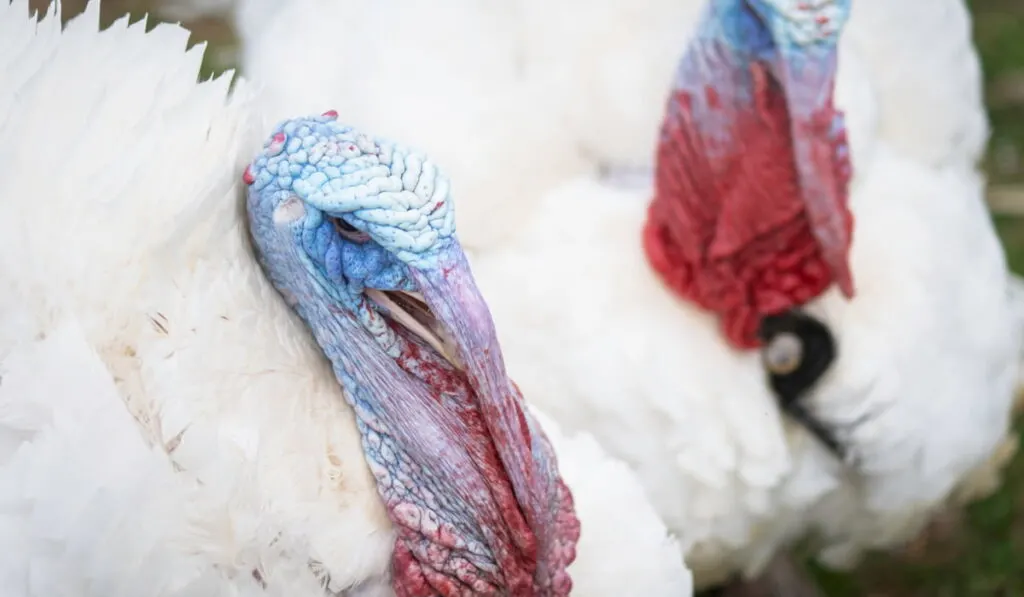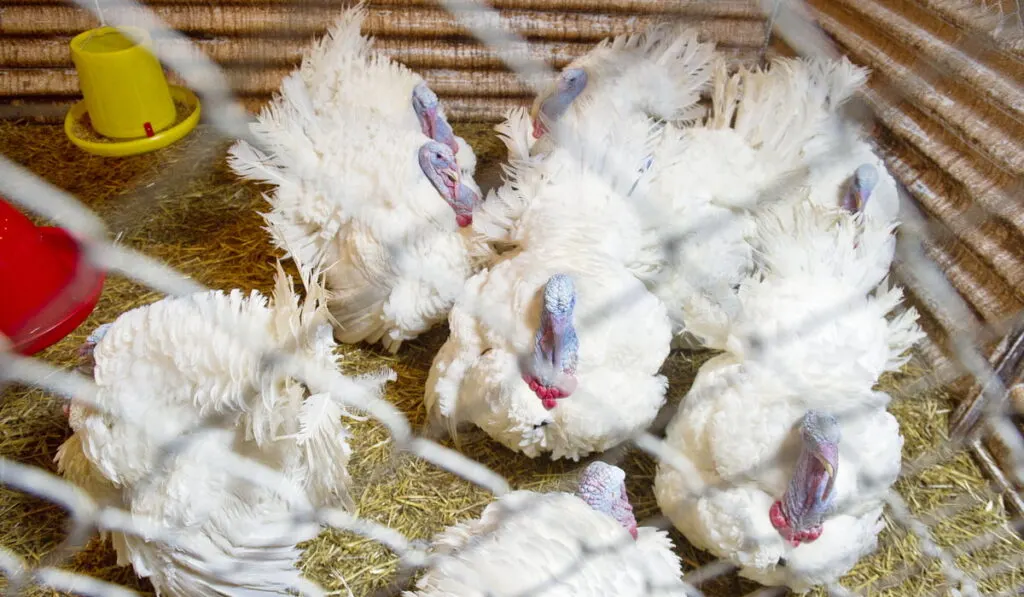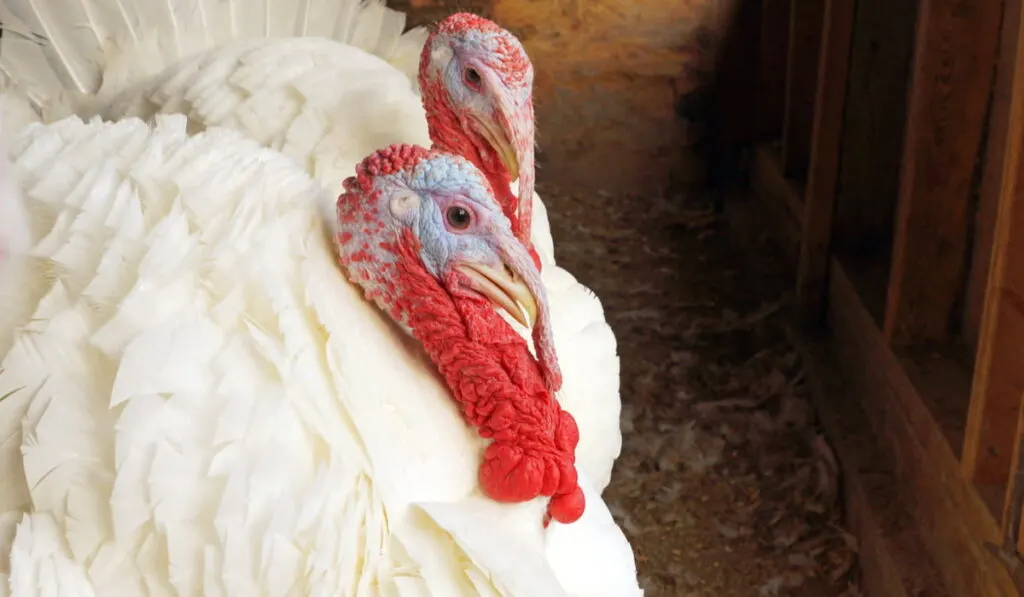The Beltsville small white turkey is a heritage breed that came into existence to satisfy consumer demand for small to medium-sized turkeys. This breed enjoyed a lot of success in the mid-1950s. But then, almost 20 years after, it almost went extinct.
Beltsville small white turkeys still exist today. And while there aren’t many of them, efforts are ongoing to conserve and even revive the breed.
In this article, we compile various details about the Beltsville small white turkey. So, if you ever wanted a Beltsville small white turkey breed profile, here you go.

Table of Contents
Origin and History
The Beltsville small white is an American breed. More specifically, it is the product of a crossbreeding program at the USDA’s Beltsville Center in Maryland. Hence, the reason “Beltsville” is part of the breed name.
The USDA’s Beltsville Agricultural Research Center started developing the Beltsville small white turkey breed in 1934. The process took about seven years, so the birds were not in use until around 1941.
The creation of the breed was in response to a consumer survey. The survey revealed that approximately 9 in 10 consumers wanted a bird weighing 8-15 pounds.
Respondents said they didn’t want the bird to have dark pinfeathers, and they wanted the bird to be meaty. The consumers wanted something small enough for their ovens, refrigerators, and families.
To create the Beltsville small white turkey, scientists used white Holland, bronze, Narragansett, white Austrian, and wild turkeys.
The Beltsville small white turkey earned recognition from the American Poultry Association in 1951. From this period until the mid-1950s, its popularity peaked.
Restaurants and hotels did not fancy the Beltsville small white turkey. Besides, processors wanted larger-sized turkeys since those would offer more portions of meat.
Also, some inexperienced breeders crossbred Beltsville small white with other breeds and created low-quality meat. For these reasons, the success of the Beltsville small white turkey was not perennial.
By the mid-1960s, the broad-breasted white — a larger-sized breed — had replaced the Beltsville small white turkey’s place in the market. Then in the 1970s, the Beltsville white almost went extinct. Fortunately, it did not go extinct.
Today, the conservation status of the Beltsville small white is still not great. However, conservation and revival efforts are underway in North America.
Characteristics
Size
As the name implies, Beltsville small whites are not the largest-sized turkeys you’ll find. In fact, they are only slightly larger than some of the largest-sized chickens.
Generally, Beltsville small white turkeys fall in the small- to medium-sized class of turkeys. The average Beltsville small white tom weighs just around 17 to 21 pounds. The hens, on the other hand, are just about 10 to 12 pounds.
Color
As their name suggests, adult Beltsville small whites have predominantly white plumage. Their poults (their young), on the other hand, have cream or yellowish plumage with no beards.
While the plumage of Beltsville small white turkeys is totally white, their heads are reddish to bluish-white.
Beltsville small white turkeys have cream-colored beaks, black beards, dark-brown eyes, and pinkish-white shanks and toes.
Egg Laying
Beltsville small white turkeys are excellent when it comes to laying eggs. If you want to get a turkey breed with a decent egg yield, Beltsville small whites are the ones to consider.
On average, Beltsville small white turkeys lay around 150 to 180 eggs per year. This makes them one of the highest egg producers amongst turkeys.
Beltsville small white eggs are large and have a pale cream to medium-brown color with spots.
Meat
After about 24 to 26 weeks, Beltsville small white turkeys reach roaster weight. Of course, going by their size, you wouldn’t expect Beltsville small whites to dress out large. But then, the hens can give you about 13 pounds of meat, while the toms offer up to 23 pounds.
One notable feature of Beltsville small white meat is how clean their carcass looks. The absence of dark pinfeathers leaves Beltsville small whites looking relatively spotless.
Uses
As you may have already guessed, Beltsville small white turkeys are primarily a meat breed. But with a laying rate of 150 to 180 eggs per year, you may also keep them for eggs.
Beltsville small white turkeys can also be ornamental birds. In fact, the primary breeders of Beltsville small whites are exhibition breeders.
In the past, Beltsville small whites were more than just purebreds. They were part of the development of variants of small to medium-sized turkeys. However, these variants were not clearly defined as breeds.
Reproduction
Beltsville small whites have desirable reproductive qualities. One of them is that they mate naturally. So, as a poultry farmer, you do not have to navigate the intricacies of artificial insemination.
Besides that, selecting, breeding, and maintaining these turkeys is pretty straightforward, even for small-scale poultry farmers. Finding a high-quality stock might be slightly taxing. But that’s just about it. Besides, once you find one, you’ll be glad you did.
Behavior/Temperament
Beltsville small white turkeys are generally docile yet friendly and outgoing. So, overall, managing them is pretty uncomplicated.
While Beltsville small whites are typically docile, some birds may be aggressive.
Pros/Cons
Pros
- Beltsville small whites have a clean carcass, thanks to their white pinfeathers.
- They mate naturally.
- Thanks to their docile temperament, you can manage Beltsville small whites without fuss.
- Beltsville small whites are also easy to select, breed, and maintain.
- Beltsville small whites are pretty hardy, and they are not particularly susceptible to any diseases.
- There is minimal risk of aerial predation to Beltsville small whites if you let them range freely.
- While they are primarily meat birds, you can keep them for eggs and ornamental purposes.
Cons
- Beltsville small whites are rare.

Hatching and Raising
Hatching
While turkey eggs hatch naturally under turkey hens, artificial hatching has some advantages.
Turkeys generally have poor maternal instincts. Besides, the hens typically get broody when they are not laying eggs. These two factors bring down the hatching rates of turkey eggs.
But with artificial incubation, the odds are way better.
The guidelines for hatching Beltsville small white eggs are similar to those of other turkeys and poultry birds. In fact, turkey eggs are relatively easier to hatch. But then, to ensure a high success rate, incubate the eggs not too long after the hens lay them.
Here’s how to hatch Beltsville small white eggs:
- If you want to store the eggs before incubation, start by keeping them in a carton with their broad end upward. Place the carton in a cupboard or cool pantry and leave the eggs in there for no more than seven days. For each day you store the eggs in the carton, the chances of hatching reduce. So, get them in the incubator as soon as you can.
- When you are ready to place the eggs in the incubator, let them sit for a few hours to reach room temperature.
- Once at room temperature, clean the eggs and incubator thoroughly.
- The temperature in the incubator should be around 99.5 degrees Fahrenheit. But if the incubator uses still air, you may add 2-3 degrees to the temperature. In any case, ensure you monitor the temperature with a thermometer. It would be even better if you placed the incubator in a room with a steady temperature.
- The humidity in the incubator should be between 55% and 60%.
- Once the incubator is ready, place the eggs in it and wait.
- After about a week, you may start candling the eggs and removing those with issues.
- By day 25, the eggs will start hatching visibly. Bring the temperature to 99 degrees Fahrenheit and raise the humidity to 75% when this happens.
- The poults should have broken out of their shells by day 28.
Raising
Feeding
In the first eight weeks of their lives, Beltsville small white poults should be on a 30% protein starter. Then after eight weeks, move them to a flock raiser that is 20% protein.
If you are raising the Beltsville small white for eggs, you’ll have to switch to game bird laying feed when laying season comes.
Housing
Beltsville small whites only need a little more space than large-sized chickens. So, a coop with five to six square feet per turkey should suffice.
The roosts in the coop should not be too high off the ground — a height of no more than 24 inches works. The turkeys may suffer leg problems from jumping off high spots if the roost is too high.
You may choose to let your Beltsville small whites roam freely. But if you want to contain them, you need a run that offers around 15 feet per turkey.
Health
Beltsville small whites are not specifically prone to any diseases. However, like all turkeys, they are at risk of blackhead, an infectious disease of the liver and intestines.
Besides blackhead, look out for the presence of internal and external parasites in your Beltsville small whites. You should even provide sufficient dust bathing space so they can get such parasites off themselves.
Avoid keeping Beltsville small whites (or any turkey breed) with chickens because of potential blackhead transmission. While chickens may not get sick from blackhead, they may transmit the disease to turkeys. So, never keep both types of poultry birds in the same space.

Fun Fact
There is a flock of Beltsville small whites at Iowa State University. The said flock serves research purposes, but the public has little or no access to it.
Prices and Where to Buy
You might find Beltsville small whites for sale through the following farms and breeders.
- Green Valley Acres (Alberta, Canada)
- Hatching eggs: $7 per egg
- Day-old poults: $30 per poult
- Started turkeys: $40 per turkey
- D&H Newman (Canada)
- Poults: $14 each
- Bentwood Farms LLC (Bush, Louisiana)
- Country Hatchery, Inc. (Wewoka, Oklahoma)
- Shinglebrook Farm (Shelburne, Massachusetts)
Resources
- https://livestockconservancy.org/heritage-breeds/heritage-breeds-list/beltsville-small-white-turkey/
- https://www.roysfarm.com/beltsville-small-white-turkey/
- https://morningchores.com/beltsville-small-white-turkeys/
- https://www.youtube.com/watch?v=JHZC2Nleq9c
- https://www.breedslist.com/beltsville-small-white-turkey.htm
- https://www.motherearthnews.com/homesteading-and-livestock/hatching-turkey-eggs-ze0z1303zgar/
- https://www.incubators.org/turkey-egg-incubation.html
- https://hobbyfarmwisdom.com/beltsville-small-white-turkeys-for-sale-in-all-states/
- https://greenvalleyacres.ca/products/beltsville-small-white-turkeys?variant=41263282979008
- https://dandhnewman.ca/chantecler-chickens/chicks/
